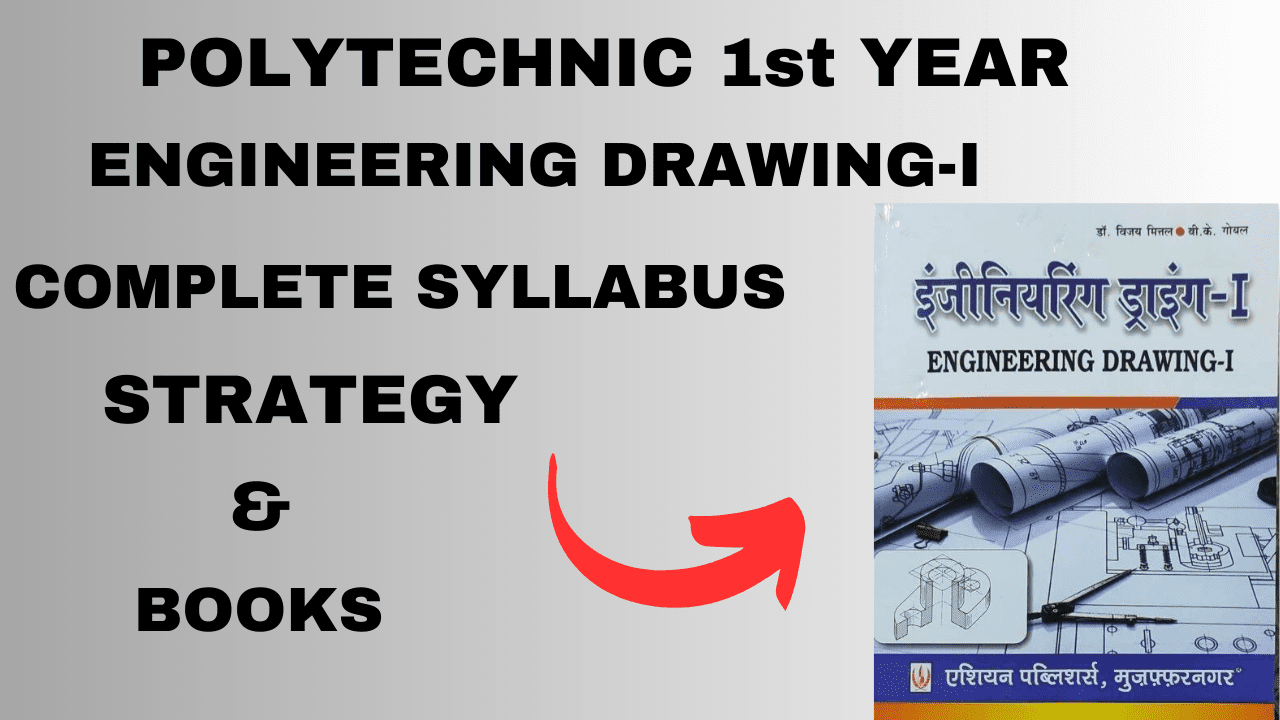Dear students, if you are a student of Polytechnic First Year First Semester of Electrical & Electronics Engineering and you want to know what are the units and lesson in Engineering Drawing 1, then you have reached the right place. Today’s post , we will tell you in detail about the Engineering Drawing 1 Syllabus which is approved by BTEUP and this is the Engineering Drawing 1 new syllabus .
Before we start the post one thing you were must know which is, Engineering Drawing 1 is a common subject in all Polytechnic branch. So let’s start the post and read about Engineering Drawing 1 detailed syllabus .

DETAILED CONTENTS OF POLYTECHNIC FIRST SEMESTER ENGINEERING DRAWING-1 SYLLABUS FOR ELECTRICAL & ELECTRONICS ENGINEERING
1.) Introduction to Engineering Drawing
1.1) Introduction to drawing instruments, materials, layout and sizes of drawing sheets and drawing boards.
1.2) Different types of lines in Engineering drawing as per BIS specifications.
1.3) Practice of vertical, horizontal and inclined lines, geometrical figures such as triangles, rectangles, circles, ellipses and curves, hexagonal, pentagon with the help of drawing instruments.
1.4) Free hand and instrumental lettering (Alphabet and numerals)- upper case (Capital Letter), single stroke, vertical and inclined at 75 degree, series of 5,8,12 mm of free hand and instrumental lettering of height 25 to 35mm in the ratio of 7:4.
2.) Dimensioning Technique
2.1) Necessity of dimensioning, method and principles of dimensioning (mainly theoretical instructions)
2.2) Dimensioning of overall sizes, circles, threaded holes, chamfered surfaces, angles, tapered surfaces, holes, equally spaced on P.C.D., counter sunk holes, counter bored holes, cylindrical parts, narrow spaces and gaps, radii, curves and arches.
3.) Scales
3.1) Scales –their needs and importance (theoretical instructions), type of scales, definition of R.F. and length of scale.
3.2) Drawing of plain and diagonal scales.
4.) Orthographic Projections
4.1) Theory of orthographic projections (Elaborate theoretical instructions)
4.2) Projection of Points in Different quadrant
4.3) Projection of Straight Line (1st and 3rd angle)
4.3.1. Line parallel to both the planes
4.3.2. Line perpendicular to any one of the reference plane
4.3.3. Line inclined to any one of the reference plane.
4.4) Projection of Plane- Different lamina like square, rectangular, triangular and circle inclined to one plane, parallel and perpendicular to another plane in 1st angle only.
4.5) Three views of orthographic projection of different objects.
4.6) Identification of Surfaces
5.) Projection of Solid
5.1) Definition and salient features of Solid.
5.2) Types of Solid (Polyhedron and Solid of revolution).
5.3) To make projections, sources, Top view, Front view and side view of various types of Solid.
6.) Sections
6.1) Importance and salient features
6.2) Drawing of full section, half section, partial or broken out sections, Offset sections, revolved sections and removed sections.
6.3) Convention sectional representation of various materials, conventional breaks for shafts, pipes, rectangular, square, angle, channel, rolled sections.
6.4) Orthographic sectional views of different objects.
7.) Isometric Views
7.1) Fundamentals of isometric projections and isometric scale.
7.2) Isometric views of combination of regular solids like cylinder, cone, cube and prism.
8.) Common Symbols and Conventions used in Engineering
8.1) Civil Engineering sanitary fitting symbols.
8.2) Electrical fitting symbols for domestic interior installations.
*9 Introduction to AutoCAD
Basic introduction and operational instructions of various commands in AutoCAD. At least two sheets on AutoCAD of cube, cuboid, cone, pyramid, truncated cone and pyramid, sphere and combination of above solids.
*Auto CAD drawing will be evaluated internally by sessional marks and not by final theory paper.
LEARNING OUTCOMES
After undergoing the subject, the students will be able to:
• Identify and use of different grades of pencils and other drafting instruments which are used in engineering field.
• Draw free hand sketches of various kinds of objects.
• Utilize various types of lines used in engineering drawing.
• Read and apply different dimensioning methods on drawing of objects.
• Use different types of scales and their utilization in reading and reproducing drawings of objects and maps.
• Draw 2 – dimensional view of different objects viewed from different angles (orthographic views).
• Draw and interpret complete inner hidden details of an object which are otherwise not visible in normal view.
• To make projections of Solid.
• Generate isometric (3D) drawing from different 2D (orthographic) views/sketches.
• Identify conventions for different engineering materials, symbols, sections of regular objects and general fittings used in Civil and Electrical household appliances.
• Use basic commands of AutoCAD.
INSTRUCTIONAL STRATEGY
Teacher should show model of realia of the component/part whose drawing is to be made. Emphasis should be given on cleanliness, dimensioning and layout of sheet. Focus should be on proper selection of drawing instruments and their proper use. The institute should procure AutoCAD or other engineering graphics software for practice in engineering drawings. Teachers should undergo training in AutoCAD/Engineering Graphic. Separate labs for practice on AutoCAD should be established.
MEANS OF ASSESSMENT
− Sketches
− Drawing
− Use of software
RECOMMENDED BOOKS
1.) A Text Book of Engineering Drawing by Surjit Singh; Dhanpat Rai & Co., Delhi.
2.) Engineering Drawing by PS Gill; SK Kataria & Sons, New Delhi.
3.) Elementary Engineering Drawing in First Angle Projection by ND Bhatt; Charotar Publishing House Pvt. Ltd., Anand.
4.) Engineering Drawing I & II by JS Layall; Eagle Parkashan, Jalandhar.
5.) Engineering Drawing I by DK Goel, GBD Publication.
Download Engineering Drawing-1 Syllabus click here
Download Applied Physics-1 Syllabus click here
Download Applied Chemistry-1 Syllabus click here
Download Communication Skill-1 Syllabus click here
Download Applied Mathematics-1 Syllabus click here
Dear Students, please comment your suggestion and for any other subject’s BOOK, notes and syllabus PDF, leave a comment and tell us how you liked this article.
To read more article like this, bookmark website booksandsolutions.in
Thank you for giving us your most valuable time.